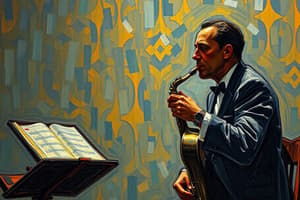Podcast
Questions and Answers
What are the roots of jazz and tap?
What are the roots of jazz and tap?
When slaves maintained their rituals and cultural values, they brought drumming and dancing to America, which evolved into vernacular jazz and tap dance.
What event allowed black performers to join minstrel shows?
What event allowed black performers to join minstrel shows?
- The Harlem Renaissance
- The introduction of blackface (correct)
- The abolition of slavery
- The Civil War
What was the cakewalk?
What was the cakewalk?
A performance by slaves for their owners where the best dancing couple would receive a cake as a reward.
Who was William Henry Lane?
Who was William Henry Lane?
What was the significance of vaudeville?
What was the significance of vaudeville?
What did the Harlem Renaissance contribute to dance culture?
What did the Harlem Renaissance contribute to dance culture?
What were the influences on the Jazz Age?
What were the influences on the Jazz Age?
Characteristics of jazz include rhythmic movement, improvisation, and ____ style.
Characteristics of jazz include rhythmic movement, improvisation, and ____ style.
Match the notable figures in jazz dance with their contributions:
Match the notable figures in jazz dance with their contributions:
Flashcards are hidden until you start studying
Study Notes
Roots of Jazz and Tap
- Originated from African slaves in 17th century America, who preserved cultural rituals and values through drumming and dancing.
- Drumming was banned, leading to adaptations of stomping, clapping, and singing, marking the beginnings of vernacular jazz and tap dance.
- Performances took place on plantations for entertainment and competition, both within slave communities and for slave owners.
From the Plantation to the Stage (1860-1900)
- Plantation songs and dances transitioned to theatre through minstrel shows in the 1830s.
- Initially, black performers were excluded; white performers utilized blackface to imitate black characters.
- By 1860, black performers participated in minstrel shows, still using blackface to appeal to audiences.
Cakewalk
- A performance contest where slave couples danced for their owners, with winners awarded a cake.
- The style mocked European ballroom dancing, often unnoticed by owners who enjoyed the comedic aspect.
William Henry Lane (Master Juba)
- Renowned jig dancer by 1845, celebrated as "the greatest of all dancers."
- Blended Irish jig and reel with African movements, establishing the foundation for American tap dance.
Vaudeville
- Played a crucial role in the evolution of American jazz dance.
- Served as a precursor to the Harlem Renaissance.
Harlem Renaissance
- Marked by the emergence of dance halls like the Cotton Club and the Savoy Ballroom, facilitating racial integration.
- Popular dances included swing, lindy hop, Black Bottom, and Charleston, connected to the musical culture of the time.
Jazz Age
- The 1920s saw rapid dissemination of jazz through phonographs, radio, and talking pictures.
- Influenced by World War I, Prohibition, and the pre-Depression boom, leading to diverse and widespread jazz experiences.
Characteristics of Jazz
- Rhythmic: Integration of music and movement through phrasing and syncopation.
- Improvisation: Emphasis on personal expression through spontaneous movement.
- Unique Style: Distinctiveness in expression and execution, with each dancer and choreographer contributing their unique approach.
- Jazz dance encompasses various styles including musical theatre, tap, lyrical, funk, swing, and Latin Jazz.
Notable Figures in Jazz Dance
- Irene & Vernon Castle: Influential ballroom dancers in the early 1900s.
- Busby Berkeley: Broadway choreographer known for his focus on visual shapes from overhead perspectives.
- Bobby Connolly: Integrated swing dance into musicals; choreographed for "Wizard of Oz."
- Jack Cole: Known as the "Father of Jazz Dance," he created a unique jazz movement vocabulary influenced by various cultural styles.
- Eugene Louis Facciuto (Luigi): An accomplished dancer and teacher who contributed significantly to jazz dance education and performance.
Studying That Suits You
Use AI to generate personalized quizzes and flashcards to suit your learning preferences.




